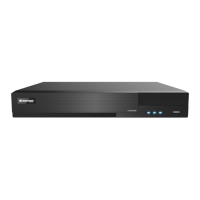
Do you have a question about the Vitek Transcendent VT-TNR Series and is the answer not in the manual?
| Brand | Vitek |
|---|---|
| Model | Transcendent VT-TNR Series |
| Category | Network Hardware |
| Language | English |
Comprehensive list of basic functions, live view capabilities, and NVR features.
Detailed explanation of front panel buttons and indicators for different model types.
Overview of rear panel interfaces and connection ports for NVR models.
Guide to video, audio, and alarm connection types and their usage.
Step-by-step instructions for powering the NVR on and off safely.
Guide to using the remote control, including battery replacement and button functions.
Instructions for operating the NVR interface using a mouse.
Explanation of keyboard input methods for text fields within the NVR interface.
Description of common buttons used for navigation and system control.
Initial setup guide for configuring language, date, time, and network settings.
Overview of the NVR's primary graphical user interface elements and navigation.
Guide to accessing and navigating the system's main setup menu and modules.
Procedures for adding, editing, and managing IP cameras connected to the NVR.
Steps for creating and managing groups of cameras for organized viewing.
Explanation of the live video display interface, toolbars, and camera controls.
Options for customizing screen layouts and camera display sequences.
Configuration for Point of Sale data integration with camera feeds.
Settings for OSD, image adjustments, and privacy masking on camera feeds.
Interface for controlling Pan, Tilt, and Zoom functions of PTZ cameras.
Managing camera presets for quick positioning and PTZ control.
Configuring automated camera movement paths (cruises) for PTZ cameras.
Recording and replaying specific camera movement paths (traces) for PTZ control.
Scheduling PTZ camera actions like presets, cruises, or traces.
Setting up recording modes (auto, manual, schedule, motion, sensor, AI) and video parameters.
Defining custom recording schedules for cameras on a daily or weekly basis.
Adjusting video encoding, resolution, FPS, and bitrate for camera streams.
Managing HDD status, formatting, data encryption, and decryption.
Organizing disks into groups and assigning cameras to specific storage groups.
Quickly accessing and playing recorded video directly from the live view.
Navigating and controlling playback of recorded video footage.
Methods for searching, playing, and backing up recorded data by time, event, or tag.
Advanced search capabilities within recorded video using motion grids, lines, or faces.
Configuring face detection, recognition, and alarm linkage based on detected faces.
Setting up LPR cameras for detecting and recognizing license plates.
Configuring virtual tripwires to detect intrusions across predefined lines or areas.
Setting up alarm zones to detect unauthorized entry or movement.
Detecting unattended or removed objects within a specified camera view.
Monitoring and alarming based on exceeding crowd density thresholds in an area.
Counting people or vehicles crossing a defined line in specific directions.
Configuring alarms for video quality issues like scene change or blur.
Viewing real-time captured images of human bodies, vehicles, and faces.
Advanced search functions for faces, tracks, human bodies, vehicles, and combinations.
Managing and tracking employee attendance using facial recognition.
System for recording and verifying employee check-ins using facial recognition.
Configuring alarms triggered by external sensors connected to the NVR.
Setting up alarms based on detected motion within camera views.
Creating complex alarm rules by combining multiple event triggers.
Configuring alarms for camera exceptions like offline status or video quality issues.
Setting up notifications for triggered alarms via alarm-out, email, buzzer, etc.
Managing user accounts, including adding, editing, and deleting users.
Defining user roles and access privileges for system functions.
Controlling NVR access based on IP address or MAC address filtering.
Configuring password strength and expiration policies for user accounts.
Setting up TCP/IP, DNS, PPPoE, DDNS, and other network parameters.
Configuring HTTP, HTTPS, RTSP, and server ports for NVR access and services.
Setting up Point-to-Point Protocol over Ethernet for internet connection.
Configuring Dynamic DNS for accessing the NVR via a domain name.
Setting up email notifications for system events and alarms.
Enabling Universal Plug and Play for easier network access.
Configuring Network Address Translation for remote access.
Updating NVR firmware and software from the cloud server.
General system settings like device name, language, and output configuration.
Setting system time, date format, and time zone for accurate logging.
Restoring the NVR to its original factory settings.
Procedures for upgrading NVR firmware via USB or cloud.
Backing up and restoring NVR configuration files to other storage devices.
Accessing and exporting system logs for troubleshooting and auditing.
Retrieving details about camera status, alarms, network, and disk usage.
Connecting to the NVR using a mobile app on Android or iOS devices.
Accessing the NVR interface via a web browser on the local network.
Accessing the NVR remotely over the internet using NAT or DDNS.
Managing NVR functions remotely through a web browser.
Viewing live camera feeds remotely via the web interface.
Accessing and playing recorded footage remotely through the web interface.
Performing searches and backups of recorded data remotely.
Remotely configuring and managing intelligent analytics features.
Remotely configuring NVR settings such as camera, record, and network.
Information regarding the three-year limited warranty terms and conditions.
